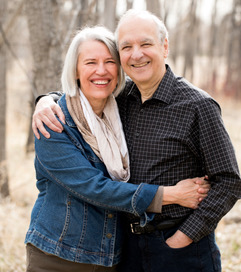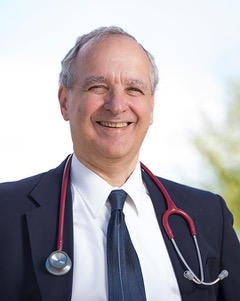Our Stories: Frank Accurso
by Tanya Accurso
It is 50 years ago April 25 that I married my best friend and partner, Frank. We had met 2 ½ years earlier in Boulder. I was studying physical therapy and here was this new boy from the Bronx, a graduate student in astro-geophysics. I was charmed when he was surprised by a real fire in the fireplace. He told me about his stick ball bat that he brought from home. I had no idea what he was talking about.
Frank was lucky to have gone to the Bronx High School of Science. When his friends went to Ivy League colleges, he decided to stay at home, help his Mom, save his money for grad school and commute to the City College of NY in Harlem. “When I first came over the hill from Denver to Boulder, I thought I had died and gone to heaven” he told me. I called him “the nerd poster child” with his slide rule in his pocket. The first year together was magical, escaping whenever we could to the mountains and Rocky Mountain National Park to hike, a passion we have to this day.
1968-69 was a tumultuous time and after that first year in grad school, Frank was struggling to figure out the draft and whether he was going to continue with his childhood dream of working towards being in the space program or do something more socially conscious. He was debating whether to move to Canada or possibly declare himself a conscientious objector to avoid the senseless war in Viet Nam. Instead, he decided to attend an intense summer program at Columbia to get a deferment through a teaching certificate. Just as he was completing that program, the lottery came in and he was fairly sure that his number wouldn’t come up for the draft. So back in Boulder he continued to work on his graduate degree and although he loved the immersion in planetary science, he felt drawn to go into medicine. While I finished my physical therapy degree at the medical school in Denver, Frank took his med school pre-requisites while completing his graduate program.
Frank’s real passion at CU at Boulder was participating in the annual Trivia Bowl. His team one year was “Finlaycin National Bank” (reference to a Laurel and Hardy set) and then “Benny Wiggins and the Flies”. They were in the finals and after Frank left for medical school, they named the team “The Return of Frank Accurso” and then “The Revenge of Frank Accurso” winning both years at the Trivia Bowl. This claim to fame followed him for years afterwards, much to his embarrassment and silent pride.
During Spring break of 1971 we were married by my father, then minister at the WheatRidge United Methodist Church. By Fall we were settled in the Bronx, Frank opting for an accelerated, 3 year medical school program at Albert Einstein School of Medicine. I threw myself into working at the Bronx Municipal Hospital or Jacobi. It was an intense but exciting time for both of us. I understood better about working, living in the Bronx, and got to know Frank’s family. We would escape on the graffiti covered subways at least once a weekend to Manhattan with friends to see Off Off Broadway shows, the Godfather movie, or eat at one of the many ethnic restaurants. Time went fast.
I was excited to be returning back to Denver near my family when Frank began his pediatric residency at the University of Colorado Medical Center and then a pulmonary fellowship. It was an easy transition understanding lung volumes and functions with his physics background. The call schedule, however, was grueling being on call for 36 hours every few days. Afterwards we had our first extended vacation traveling around Europe in a Citroen from Scandinavia to the Greek Islands. He was invited to join the Univ. of Colorado pediatric faculty as a pulmonologist upon our return.
It seemed like there was no relief for Frank continuing to take call and working on multiple projects, learning and researching lung physiology of sheep and infants. It was a struggle, juggling all the demands of an academic career, teaching, writing papers, doing clinical work and now being a father of 2 boys. When Frank started on the faculty there was only one other pulmonologist and a couple nurse practitioners on the staff. When he retired in 2016 there were 20 MDs in pediatric pulmonology and 20+ nurse practitioners. Frank became the cystic fibrosis center director in 1987 (see below) and became pulmonary section head in 2003. All these hats took a stressful toll on him.
It feels a little bit like a family affair to be married to a committed academic like Frank. It was my job to keep home intact and functioning with my own job and the kid’s schedules. Although I was raised in Methodism, I made an alternative decision that we join the First Universalist Church in Denver. UUism aligned more with my way of thinking. I was happy to have my children grow and learn in this accepting environment. We took family vacations every year but they were always trips associated with conferences. Fortunately, they included trips to England, France, Italy, and Germany for the European CF meetings. As the boys got older they had opportunities to travel that few other kids had.
On Sept 11, 2001, Frank and I were in the airport waiting to board a plane to Alabama. Frank was to accept an award for his work on CF. Fortunately the plane did not leave as we heard the events unfold on overhead TV’s in the airport. When we returned home, I called his office manager to not let Frank open his schedule with any commitments. We were going to take a much needed mini vacation to Estes Park. The boys were both in college now and we both, independently, said maybe we should look at some Estes Park cabins or condos. We did and luckily found one to purchase. This began a pattern where we travelled up to Estes Park on most weekends to hike and work on some extra paper work and projects. I would pick him up at Children’s Hospital on Friday evening with his boxes of files and then drop him there on our return Sunday afternoon.
Cystic Fibrosis, a genetic disease affecting ~1/4,000 -most affected are lungs but also pancreas and other organs
Accepting the role of Cystic Fibrosis Center Director in 1987 was a big step in directing and focusing Frank’s career. He relished the increased independence it offered, not being quite so torn between Children’s, National Jewish, the University, but there were still competing factions for grants, national and local funding, research and clinical projects. When he took on this role, life expectancy was 18 for children with CF and when he retired it was 48 years. He acknowledges how much he learned by treating these kids and their families, keeping an upbeat, optimistic attitude while being trusted to be honest, reassuring them about their treatment and explaining the cause.
The first big project Frank undertook was a collaboration with the lab by using the new born heel stick blood spot to use as a screening tool for CF. This started in ~1980. Over the next 20 years Frank showed how early intervention improved better growth, better lung function, fewer exacerbations. In 1982 he lobbied Colorado legislature to fund (with $1/test) a state wide screening with this blood spot. Previously and still in most of the country, kids were hospitalized two times before they were diagnosed with CF. They would present with a multitude of issues before they would be tested for CF. In 1989 the CF gene was identified by Frances Collins and others but early screening became controversial due to the possibility that families would opt for abortion in subsequent children.
There were seven regional research CF centers all over the country in 1999. Colorado included Montana and Wyoming, It soon became the largest center with 600+ children because they were the first to screen and treat newborns. Now there are 80 research centers across the country.
The 2000s ushered in an explosion of new treatments. The CF Foundation had a visionary CEO who sponsored grants and began venture philanthropy. This is when a foundation provides support for a company to do research. One company took the opportunity to use high-through-put screening of thousands of compounds to find something that would affect the basic defect in CF, the CFTR or chloride channel. They had a “hit” in about 2003 but it took several years to develop a drug that could be tested clinically. Frank was closely involved in this development and was fortunate to do the phase two clinical trial, using his sophisticated lab to test samples from patients in centers across the country. “This was the most exciting time of my career”. He says that he could see that the data was clear for a positive outcome for a specific mutation. The pulmonary tests and sweat tests were unequivocally better in some of the patients than others. They, of course, were the ones receiving the new drug. Looking at the data was a “Ah ha and OMG” and “I couldn’t tell anyone until all the data was finished being analyzed”. The data was compiled in 2006 but the study was published in the New England Journal in 2010. They have since modified and developed the treatment for other mutations, improving the quality for more and more kids and now adults with CF. “I feel extremely lucky to have been a part of this exciting time in CF”. Life expectancy now is 48 years. He was beloved by his patients, often being involved in their care for their entire life. He also trained many fellows and residents many of whom still contact him with career questions. His door was always open. He loved being a part of the national and international family of researchers that made the incredible progress in pulmonary but especially cystic fibrosis.
As I look back on the past 50 years, I feel that I found the right guy. Happy Anniversary, Frank.


